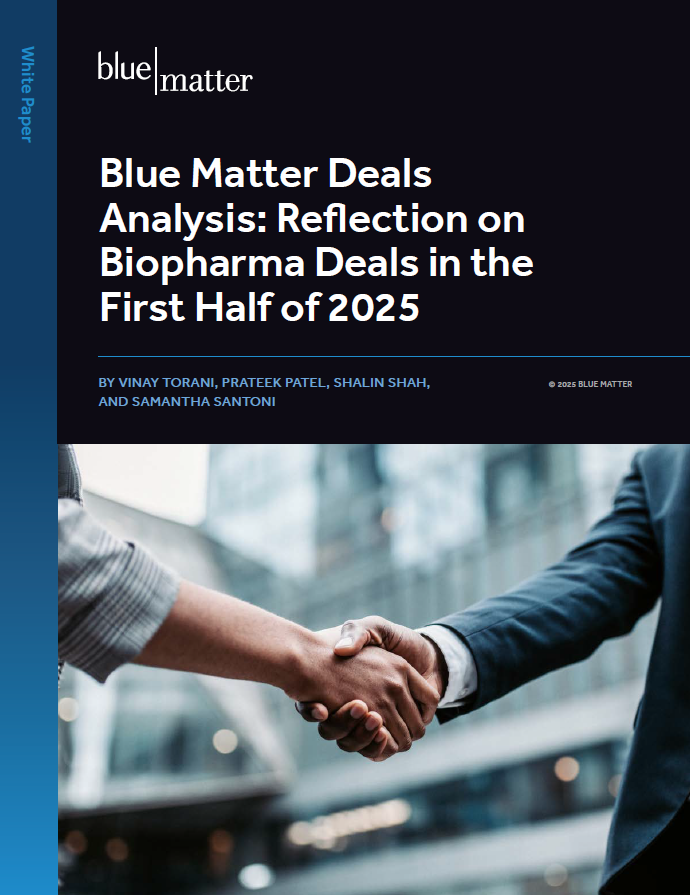
To succeed, an emerging biotech firm needs to maximize the value of its therapeutic asset(s) as they move through the development process and hopefully to market. It will typically realize that value via a series of transactions with investors and/or partners. Ideally, those transactions culminate in the therapy’s successful commercialization, either by the company itself or through one or more partners or acquirers.
Throughout the process, the leadership of an emerging biotech company must understand the key value drivers for the company (i.e., what key assets are driving value) as well as the potential value of those key assets. They must also be able to communicate that to investors in a way that’s relevant, credible, and engaging. This is essential to acquiring the capital and resources needed to advance an asset and optimize ROI.
In Part 1 of this series, we covered three important items:
- Why a strong commercial proposition is needed
- How decision makers within the company must align on some key things before developing that proposition
- The core components of a commercial proposition
Here, in Part 2, we address the key success factors that companies should consider when communicating value to potential investors or partners.
Key Success Factors
Articulate your vision and objective
Before developing a value proposition and narrative targeted at potential investors, it’s important to articulate your own company’s strategic vision, your business objectives, and your reasons for engaging with a potential investor or partner. The thought processes that are required to concisely articulate those components provide a necessary foundation on which to build subsequent, outward-facing messages.
Also, Company leaders should be open and transparent with potential investors regarding their ultimate vision and intentions. For example, is the company looking to partner moving forward to co-develop or co-commercialize, is it seeking to divest or out-license, or to self-commercialize?
Clearly communicate your value proposition
At the highest level, it’s essential to convince a potential investor that the asset(s) in question are valuable and why. In most cases, it’s equally important to convince them that the company is uniquely positioned or qualified to help develop and realize that value. Typically, the message platform that highlights your value proposition should:
- Outline the company vision and long-term strategic objectives
- Highlight the strength of the management team, the Board of Directors, and the scientific advisors
- Articulate the company’s evolution, the unique attributes of the asset(s) or platform, the asset’s development status, clinical evidence, and competitive positioning
Clearly highlight the core components of the commercial proposition
In Part 1, we described the core components of a robust commercial proposition for an asset:
- Market / Competitive Landscape – Including the existing standard of care, current therapeutic alternatives, pipeline therapies, and future treatment paradigm
- Unmet Need – What is the current unmet need in the market? How is the asset or platform positioned to address this unmet need? Why is it a better solution than other available (or future) alternatives?
- Target Patient Population(s) – Specific, well-defined patient population for the asset
- Potential Market Size – Total addressable market for the asset based on the target patient population and likely pricing
- Revenue Forecast – Robust and defensible revenue forecast for the asset through loss of exclusivity (LOE) considering peak market share potential, physician adoption and uptake, pricing and access, and competitive impact
For any given interaction, you may not need to include all the components in your narrative and in some cases, you may need to emphasize scientific aspects more than commercial ones. However, some level of commercial proposition should be included. The level of detail will depend on your objectives and on your audience, which leads to the next key success factor.
Tailor communications to your audience and align with your objective(s)
While the core messages in your value proposition and commercial narrative should remain consistent, it’s wise to tailor your presentation—to a certain extent—to your audience’s situation and perspectives. For example, if an asset would be an especially good strategic fit within a specific investor’s portfolio, then you may want to include messaging to stress that point when engaging with that investor.
Typically, the stage of the company, the purpose for raising the capital, and the amount of capital that one is seeking will guide the type of investors a company will target and hence, the communications for the audience. Here are some typical situations for biotech companies (not exhaustive):
- Early-Stage: Typically, early-stage companies that are in discovery or preclinical stages are trying to raise a Seed or Series A round from institutional investors to fund research, get ready for an IND meeting with the FDA, or initiate Phase 1 trials. The focus of communications should be on the science and preclinical data, including how innovative the therapy is and how it will break the current status quo or address an unmet need. Commercial elements of the narrative will typically be abbreviated, designed to briefly show that the asset is intended to address a promising market.
- Mid-Stage: Companies that are in clinical development and are in Phase 1 or 2 are likely trying to raise a Series A or B round (from existing and/or new investors). Investor communications should be a balance of scientific information and messages regarding the commercial potential of the asset. The scientific communications should highlight how innovative the therapy is, the existing trial design and clinical data (even if interim). The commercial communications should focus on the current and future competitive landscape and how the asset is positioned to succeed, the overall market size (existing and future), and the commercial potential for the asset.
- Late-Stage: Typically for companies that are in late-stage development (Phase 3 or first commercialization) and are trying to raise crossover funds, in the capital markets or from non-traditional sources (PE, product financing, or royalty financing), the objective is to run Phase 3 trials or to commercialize the asset. While the science and clinical evidence are critical, there should be a significant emphasis on the clinical development plan, the market and commercial opportunity including any market research done to validate the market need, the overall market size and attractiveness, access and pricing, and the overall commercial opportunity for the asset. Further, it is important to highlight the management team’s experience in taking the company from R&D to commercial.
In addition, it’s important to understand the intentions of the potential investor. For example, do they want a minority position or control? Do they do club deals? Do they have board seat requirements? Do they want operational involvement? What is their investment time horizon and return expectations? This understanding will help you make sure you’re partnering with the right investors.
Keep it simple and consistent
Make sure that the narrative focuses on the most important and relevant information. It should systematically build the scientific and commercial case for the asset in a way that is consistent and easy to follow: Stay on message.
Focus on the primary value drivers. For example, for an asset-driven company, zero in on the lead asset and indication that will be the primary driver of value. Don’t distract investors by emphasizing earlier stage assets. For a platform company, focus on the unique attributes of the platform technology and the ability to more effectively develop multiple assets.
Sometimes, there is a strong urge to inject an extreme amount of scientific detail into the narrative, or perhaps an inordinate amount of financial detail that seems “nice to have” but isn’t directly relevant to the value narrative. What drives this urge? In most cases, company leaders perceive that it lends credibility. It might…but there’s a greater chance that it distracts from the core message and gets potential investors off track. So, resist the temptation to go into extreme detail unless it’s clearly needed for the interaction. Avoid a long 50+ slide presentation. However, it’s advisable to have detailed information available as a back-up in case an investor asks in-depth questions. That’s better than being unprepared.
Make It easy for the investors to validate
Any given investor may be looking at dozens of investment opportunities, so they are often operating under time and resource constraints. Therefore, providing a succinct story for the company, its asset(s), commercial opportunity, and value proposition is critical.
A potential investor will start with the management presentation but will conduct its own analysis to get comfortable with the opportunity and the investment thesis. You may get only one shot to make the case, so it pays to make it easier for investors to understand and assess the commercial opportunity and value proposition of the asset during their own due diligence.
To lay the groundwork, it’s essential to provide a compelling description of the asset, the clinical evidence, the unmet need, and how the asset addresses the unmet need and hence, drives to a compelling commercial opportunity.
To articulate the commercial opportunity, leverage a well-formulated market sizing and peak revenue potential or forecast model (which is even more important for later stage assets). It’s best to support key assumptions such as the epidemiology, target patient population, pricing, access, competitive impact, and market share, with independent sources for the investor to check and validate. These can include publications, analogs, primary market research, and other sources.
The forecast model, epidemiological funnel, and revenue build should be simple, logical, and easy to follow. You may provide additional validation for the commercial opportunity by using analyses of analog assets. Highlight opportunities, risks, and mitigation strategies. The easier and more straightforward it is for an investor to understand and validate your projections, the better.
You only get one chance to win over an investor. That’s why it’s so important to communicate your value proposition clearly, succinctly, and effectively while underpinning it with factual, independent, and reliable data. Finally, understand the investor’s strategy so you can tailor your messages to their needs and perspectives. That will greatly increase the probability of an effective partnership.









